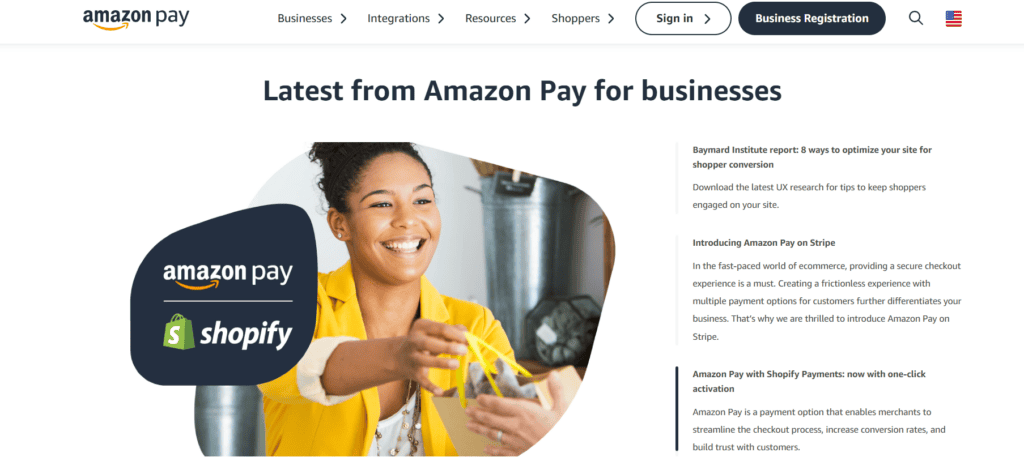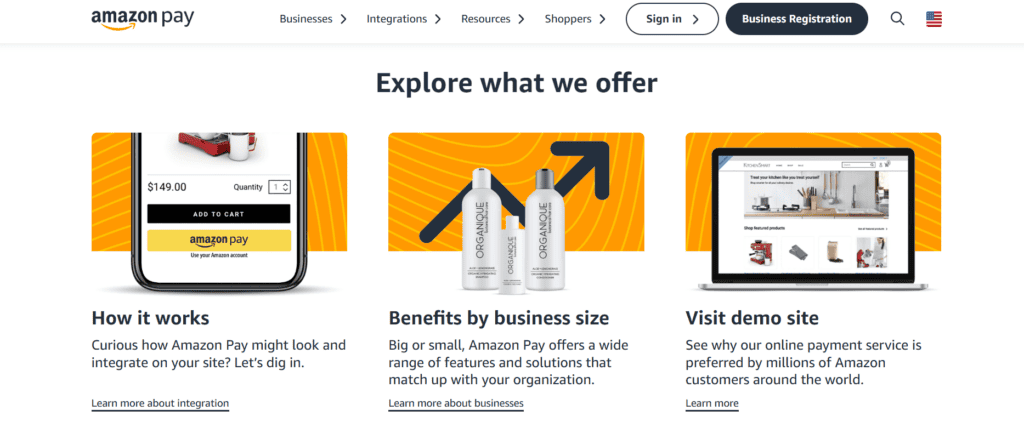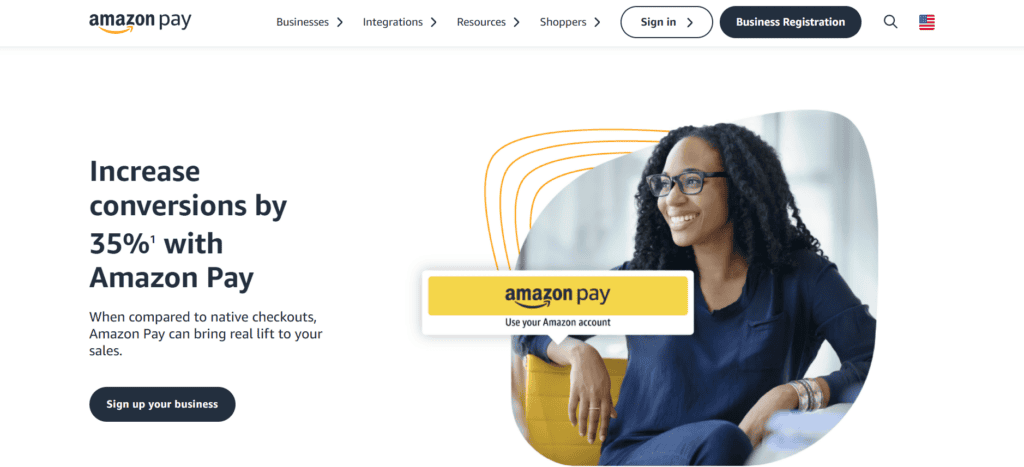Amazon Pay Review

Amazon Pay is a digital payment system that was first introduced in 2007 with the goal of making online purchases easier for both businesses and customers. It enables customers to make purchases using the payment methods that are already connected to their Amazon accounts and is based on Amazon’s incredibly reliable e-commerce infrastructure. The technology offers a smooth checkout process for customers and lowers cart abandonment for retailers by doing away with the need to manually enter billing information or create new user accounts. Lets read more about Amazon Pay Review
Over time, Amazon Pay has transformed into more than a simple checkout option. It now includes features like voice-based payments via Alexa and easy integrations with popular ecommerce platforms, offering both security and speed. Backed by Amazon’s technical capabilities and reputation, it ensures frictionless transactions, making it appealing for online retailers aiming to optimize user experience.
That said, Amazon Pay competes with well-known names like PayPal, Google Pay, and Apple Pay. What gives it an edge is its integration with Amazon’s ecosystem, millions of shoppers already trust the brand and have stored payment information, which can significantly improve merchant conversion rates.
How Amazon Pay Works | Amazon Pay Review
Amazon Pay acts as a payment gateway that enables customers to use their Amazon credentials to make purchases on third-party websites. The checkout process is simplified, users log in with their Amazon accounts and confirm payments without re-entering details.
A user is taken to a secure page hosted by Amazon to select payment options and confirm their order when they choose Amazon Pay at checkout. They are returned to the merchant site after confirmation. Because of Amazon’s reliable infrastructure, this stands out while mirroring the ease of digital wallets.
For businesses, Amazon Pay integrates via APIs or plugins with platforms such as WooCommerce, Shopify, and Magento. It supports both one-time and recurring payments, making it ideal for retail, subscription, and digital service businesses.
Voice commerce is also part of the offering. Through Alexa-enabled devices, customers can manage subscriptions and place orders, a valuable edge in the fast-evolving commerce landscape.
Transactions are managed securely through Amazon’s backend. A comprehensive merchant dashboard provides access to order tracking, refunds, and performance metrics. The setup is relatively simple, even for businesses without in-house developers.
Key Features and Services
Amazon Pay brings a rich set of features to both consumers and businesses:
One-click checkout: By using stored Amazon data, customers bypass manual entry of billing/shipping info.
Alexa payments: Customers can transact via voice using Alexa-enabled devices.
Recurring billing: Businesses offering subscriptions or memberships benefit from built-in recurring payments.
Mobile optimization: The interface is responsive and functions smoothly across mobile browsers and apps.
Brand trust: The Amazon name boosts buyer confidence, especially on lesser-known websites.
Additional features include:
Multi-currency support
Buyer protection programs
Developer-friendly APIs and SDKs
Support for refunds and partial captures
But there are disadvantages. There are no built-in invoicing features in Amazon Pay, and developers may need to be involved in order to customize the checkout process. However, its wide range of products makes it appropriate for companies trying to increase customer convenience and foster trust.
Merchant Experience and Onboarding
Signing up with Amazon Pay is a relatively simple process. Merchants need to provide business credentials, complete identity verification, and integrate the service into their website.
The platform supports both custom integrations and pre-built plugins for Shopify, BigCommerce, WooCommerce, and others, accommodating both tech-savvy teams and those without coding knowledge.
The merchant dashboard, while basic, covers core needs like viewing transaction history, issuing refunds, and downloading reports. It may not offer as many customizable insights as other platforms, but it’s intuitive and functional.
During onboarding, documentation and ticket-based support are accessible. But according to some users, support response times are slower than those of competitors who provide live chat or dedicated account managers.
Additionally, Amazon Pay isn’t available for all business categories. High-risk industries or those with ambiguous product offerings may experience approval delays or outright rejections.
For most standard ecommerce businesses, the onboarding is smooth, and Amazon Pay’s brand appeal can improve buyer trust right from the start.
Customer Experience
Amazon Pay excels at making the checkout experience fast, safe, and intuitive for end users. Shoppers can quickly complete purchases using saved Amazon credentials, minimizing data entry and reducing checkout time.
This one-click experience is especially helpful on mobile devices, where cumbersome forms often lead to cart abandonment. Real-time notifications and confirmation emails further enhance transparency and user confidence.
Brand familiarity is important. Even when they are shopping on unknown merchant websites, customers are more likely to trust a payment method that carries the Amazon name. Businesses frequently see an increase in conversions as a result of this trust.
Alexa-powered payments are another user-focused feature. While adoption is still limited, the integration allows for voice-activated purchasing, particularly useful for repeat orders and subscriptions.
A downside: users who don’t have an Amazon account must sign up to use the service, potentially introducing friction. Additionally, Amazon Pay doesn’t support every local payment option, which can limit its appeal in certain international markets.
Fees and Pricing Structure
Amazon Pay’s pricing is competitive and easy to understand. For U.S. transactions, merchants are charged 2.9% + $0.30 per domestic transaction. International payments incur a slightly higher fee of 3.9% + $0.30, similar to rates from Stripe and PayPal.
There are no setup fees, monthly subscriptions, or cancellation charges, making it suitable for startups and small businesses looking to avoid fixed costs.
As is usual in the industry, refunds are permitted, but the fixed $0.30 portion of the transaction fee is not. Chargebacks cost about $20, which is again in line with industry standards.
Amazon also offers seller protection in the case of fraudulent or unauthorized transactions, although merchants are advised to read the terms carefully.
The pricing is transparent and straightforward, which helps with financial planning. However, high-volume merchants may find more competitive rates with providers offering custom pricing structures.
Supported Countries and Currencies
Amazon Pay supports a limited but growing list of countries, including the U.S., UK, Germany, France, Italy, Spain, Japan, and India. While this covers many major ecommerce markets, it falls short of the global coverage offered by PayPal or Stripe.
Customers can pay in their local currency thanks to multi-currency support, which lowers cart abandonment. However, Amazon’s exchange rates might not always be ideal, and there is no real-time currency conversion available.
Cross-border payments are possible, but both buyer and seller must be based in supported regions. Additionally, certain products and industries may be subject to restrictions depending on the country.
Merchants should verify whether Amazon Pay is available for their business type and region before onboarding.
Security and Fraud Protection
Security is one of Amazon Pay’s strongest assets. Built on Amazon’s infrastructure, it is PCI DSS compliant and employs SSL encryption and layered security measures. Customer credentials are protected via two-factor authentication and are never shared with merchants.
Fraud prevention is built-in, with algorithms monitoring for suspicious behavior. Amazon’s A-to-Z Guarantee adds a layer of protection for buyers and helps resolve disputes.
Nonetheless, merchants have limited access to fraud management tools. The majority of fraud detection is handled internally by Amazon Pay, with little transparency or seller customization, in contrast with Stripe Radar or PayPal’s comprehensive fraud dashboards.
Still, the system is effective for most use cases, and merchants benefit from Amazon’s secure environment without needing to manage sensitive data themselves.
Integration Options
Amazon Pay provides flexible integration paths suitable for both developers and non-tech-savvy users. For advanced teams, the API allows custom checkout workflows, recurring billing setups, and mobile app payments.
Pre-built plugins are available for platforms including:
Shopify
WooCommerce
Magento
BigCommerce
PrestaShop
These allow for plug-and-play integration, making the setup simple for most ecommerce businesses. Developers also get access to a sandbox environment and thorough documentation.
The user interface’s lack of extensive customization is one obvious drawback. The Amazon Pay interface may be restrictive for merchants seeking a fully branded checkout experience. Developer involvement might be necessary for complex flows or multi-step, custom forms.
That said, the platform supports both simple and advanced use cases and can be scaled according to business needs.
Performance and Reliability
Amazon Pay operates on Amazon’s global cloud network, ensuring near-instant transaction processing, high uptime, and robust reliability. Even during high-traffic events like Black Friday, the platform delivers consistent performance.
Merchants benefit from low latency and minimal checkout interruptions, leading to fewer abandoned carts and improved user satisfaction.
Real-time updates are provided by the merchant dashboard, which also makes reporting tools easily accessible. However, unlike competitors, Amazon does not provide real-time incident reports or public system status dashboards.
Customer support during technical outages is also limited, with no live assistance. Businesses requiring immediate support may find the ticket-based system insufficient.
Despite this, the overall performance is stellar, with minimal disruptions reported even during major shopping periods.
Mobile and Voice Commerce Capabilities
Amazon Pay shines in mobile and voice commerce. The service is fully responsive and performs well on mobile browsers and apps, providing a smooth user experience across devices.
Developers can enable in-app payments through the API, ensuring checkout is seamless within mobile apps. The platform’s lightweight design means quicker load times and better conversion rates.
What really sets Amazon Pay apart is its voice commerce integration. Alexa-compatible devices allow customers to place orders, reorder items, and manage subscriptions using simple voice commands.
For repeat purchases, this is particularly useful, a customer can say, “Alexa, reorder my vitamins,” and the transaction completes with stored payment and delivery preferences.
Nevertheless, the majority of these voice characteristics are exclusive to the Amazon ecosystem. This feature might not be important to users or companies that are not Alexa investors, and some users still have privacy and data tracking concerns.
Still, for future-facing ecommerce brands, Amazon Pay’s voice and mobile capabilities offer significant potential.
Use Cases: Ideal Business Types
Amazon Pay is an excellent fit for consumer-facing ecommerce businesses that prioritize user trust and ease of checkout. It works especially well for:
Online retailers
Subscription-based services
Digital goods providers
Donation platforms
Small and medium businesses benefit from the low barrier to entry, lack of monthly fees, and ease of setup. The platform’s design also appeals to companies with limited technical resources.
However, companies with complicated invoicing requirements (like B2B services) or those in high-risk industries might find Amazon Pay restrictive. Additionally, it is not the best option for retailers who deal in goods that are listed as prohibited categories by Amazon or who operate in nations that are not supported.
Customer Support and Resources
Amazon Pay’s customer support is its most polarizing aspect. While integration resources and developer documentation are robust, merchant support is mostly ticket-based, with no live chat or phone options for standard users.
Response times vary, and some merchants report delays, particularly during holidays or peak periods. For businesses handling urgent technical or transaction-related issues, this can be a drawback.
Amazon does offer:
A knowledge base
Integration documentation
Developer forums
Although these self-service options are extensive, they may not be enough for everyone. Enterprise clients with negotiated agreements may be eligible for dedicated support.
In general, Amazon Pay is best suited for merchants who can operate with minimal hand-holding or who already have experience with self-managed platforms.
Pros and Cons
Pros:
Widely trusted brand recognition
Seamless checkout with stored Amazon credentials
Quick integration with major ecommerce platforms
Voice and mobile commerce ready
Strong security and fraud protection
No setup or monthly fees
Cons:
Limited global availability
No real-time support (chat or phone)
Limited fraud tools for merchant-side control
Amazon account required for customers
Not suited for high-risk or B2B invoicing needs
Amazon Pay does a great job of balancing performance, trust, and ease of use. It can simplify checkout and increase conversion rates for the suitable business model. Others, however, might find it difficult due to restrictions in customer service and worldwide support.
FAQs
Is Amazon Pay only for Amazon sellers?
No, Amazon Pay is open to all online merchants. You don’t need to sell on Amazon’s marketplace, it can be integrated directly into your own website.
Does Amazon Pay store or share customer data with merchants?
Amazon Pay uses stored information from the customer’s Amazon account but doesn’t share full data with merchants. This keeps user data secure while enabling easy transactions.
How long do Amazon Pay payouts take?
Payouts generally take 3–5 business days to reach a merchant’s bank account. New merchants may experience slightly longer delays during verification.








